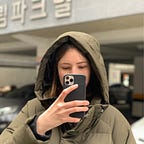06 | Micro UX: Testing
Group members: Damul Yang, Moxue Jia, Giada Han and Maria Shuttleworth
<<< For my previous project on Micro UX, click here.
Last week the class noted that they disliked the questionnaire aspect of the experience as it reduced immersion, so we decided to remove it completely. Instead, we focused on emphasising the role of movement in our outcome, as well as framing the project by thinking of where we would place it in the world.
We spent a lot of time together, thinking about where the outcome would be displayed. I thought that it would be best to make a lo-fi sketch of it in Figma, where we would be able to plan it out better than we would be able to in our heads.
We ended up deciding on this layout, although we did not know how possible it would be to project on three walls at once. For the time being, we decided to project on one wall, with the participants entering the room through a circle — emulating the lens of the microscope, only scaled up.
My main role this week was to experiment with real-time visuals in TouchDesigner: imposing webcam visuals onto the display as well as getting it to react to movement like we described in idea 1 last week.
The reason why we were imposing ourselves on this at all was because we wanted to highlight the human role in the microclimate crisis, at a cellular level. To emphasise this negative effect, I made my movements a bright red:
Setting up.
We set up our experience in a small room next to our classroom. We covered the walls with black paper, and projected the visuals onto the wall. For now, we placed the webcam and laptop on a table so that participants could clearly see where their movements would be picked up. We also set up a temporary entrance of a curtain of black card, that participants could clamber under to get into the space.
Presentation.
We decided beforehand that we would use Giada’s TouchDesigner work instead of my own. For the presentation we guided volunteers into the space, where we told them were they could move and then let them play around with the camera and their effect on Giada’s visuals onscreen.
Feedback.
The main concern was that the experience may not be understandable without the presentation as a counterpart — we need to give more explanation beforehand, so the participant understands the meaning of what they are doing. Additionally, their movements were not clear on the projection, which is something we noticed too. They commented that we could work on this by incorporating the use of colour more obviously.
Finally, John and Al commented that our interaction needs finessing: at the moment it is just a person walking into a room with a laptop screen, webcam and projection. There is no mystery to the experience, so this is something we needed to work on.
The feedback session was very useful as always, and we took it all into consideration moving forwards into the final week.
>>> For my next project on Micro UX, click here.
